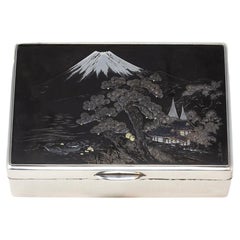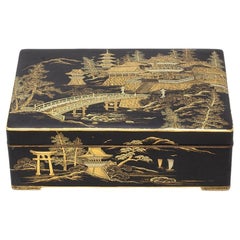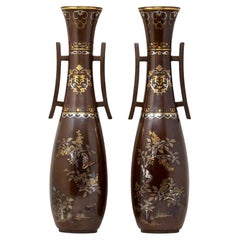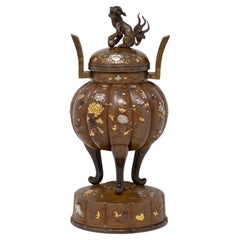Want more images or videos?
Request additional images or videos from the seller
1 of 16
Antique Japanese Meiji Period Bronze Mixed Metals Koi Carp Box
$4,825.14List Price
About the Item
- Dimensions:Height: 1.78 in (4.5 cm)Width: 3.86 in (9.8 cm)Depth: 2.76 in (7 cm)
- Style:Meiji (Of the Period)
- Materials and Techniques:
- Place of Origin:
- Period:
- Date of Manufacture:Circa 1890
- Condition:Wear consistent with age and use.
- Seller Location:Newark, GB
- Reference Number:Seller: SBKDD1stDibs: LU6971241107502
About the Seller
5.0
Gold Seller
Premium sellers maintaining a 4.3+ rating and 24-hour response times
Established in 2019
1stDibs seller since 2022
39 sales on 1stDibs
Typical response time: 2 hours
Authenticity Guarantee
In the unlikely event there’s an issue with an item’s authenticity, contact us within 1 year for a full refund. DetailsMoney-Back Guarantee
If your item is not as described, is damaged in transit, or does not arrive, contact us within 7 days for a full refund. Details24-Hour Cancellation
You have a 24-hour grace period in which to reconsider your purchase, with no questions asked.Vetted Professional Sellers
Our world-class sellers must adhere to strict standards for service and quality, maintaining the integrity of our listings.Price-Match Guarantee
If you find that a seller listed the same item for a lower price elsewhere, we’ll match it.Trusted Global Delivery
Our best-in-class carrier network provides specialized shipping options worldwide, including custom delivery.You May Also Like
A Meiji period moriage cloisonné box and cover with two carp
Located in Lymington, Hampshire
A Meiji period moriage cloisonné box and cover with two carp, the rectangular box worked in coloured enamels in standard, moriage (raised) and musen (wireless) cloisonné with one gre...
Category
Antique 19th Century Japanese Meiji Decorative Boxes
Materials
Ceramic
Mid-19th Century Japanese Meiji Period Bronze Stamp Box
Located in Chapel Hill, NC
Mid-19th century Japanese Meiji period bronze stamp box. Applied castings of a hanging flower basket with bird, recumbent stag and flowers. Measures: 1 1/...
Category
Antique Mid-19th Century Japanese Meiji Decorative Boxes
Materials
Bronze
$160 Sale Price
28% Off
H 0.88 in W 1.5 in D 1.25 in
Japanese Maki-e Lacquer Stacking Box, Jubako, Meiji Period, Japan
Located in Austin, TX
A fine and impressive Japanese gold maki-e decorated black lacquer five-tier jubako with presentation tray, two lids, and the original tomobako storage box, Meiji period, late 19th c...
Category
Antique Late 19th Century Japanese Meiji Lacquer
Materials
Lacquer
Antique Meiji Period Japanese Lacquer Inro Box, 19th Century
Located in Amsterdam, Noord Holland
Lovely Antique Meiji Period Japanese Lacquer Inro, 19th Century
Additional information:
Period: 19th century, 20th century
Region of Origin: Japan
Japan Dynasty Period: Meiji Period...
Category
Antique 19th Century Japanese Meiji Decorative Boxes
Materials
Lacquer
Lovely Antique Meiji Period Japanese Lacquer Box, 19th Century
Located in Amsterdam, Noord Holland
Lovely 19th c Antique Meiji Period Japanese Lacquer box.
Additional information:
Material: Lacquer
Region of Origin: Japan
Period: 19th century, 20th century
Japan Dynasty Period: M...
Category
Antique 19th Century Japanese Meiji Decorative Boxes
Materials
Lacquer
Japanese Meiji Period Antique Lacquer Box with Gold Maki-e Decoration
Located in New York, NY
A fine antique Japanese Meji Period lacquer box decorated with a fan and a stylized star shaped window in the maki-e technique. The fan at the top right corner, fully opened depictin...
Category
Antique 19th Century Japanese Meiji Lacquer
Materials
Lacquer
$1,700
H 4.5 in W 3.25 in D 1.88 in
Japanese Cloisonne Box by Inaba, Meiji Period, circa 1900, Japan
By Inaba Cloisonne Co.
Located in Austin, TX
A fine Japanese cloisonne hinged box with pheasant and autumn foliage, by Inaba Nanaho and the Inaba Cloisonne Company, Meiji period, circa 1900, ...
Category
Antique Early 1900s Japanese Meiji Metalwork
Materials
Copper, Enamel, Metal
Small Japanese Meiji Period Cloisonne Round Box, circa 1910, Japan
Located in Austin, TX
A small and delightful Japanese yellow ground cloisonne round trinket or incense box, Meiji Period, circa 1910, Japan.
The small box of squat, round shape, and may originally have b...
Category
Vintage 1910s Japanese Meiji Decorative Boxes
Materials
Copper, Enamel
Antique Japanese Pencil Box Lacquer Ware Writing Meiji Period, 19th C
Located in Amsterdam, Noord Holland
A Japanese lacquer writing box 19th Century
Of rectangular shape, overall painted in famille rose colors with flowers, all on a yellow ground, the interior in red.
Additional inform...
Category
Antique 19th Century Japanese Meiji Decorative Boxes
Materials
Lacquer
$455 Sale Price
20% Off
H 1.58 in W 11.7 in D 3.67 in
Japanese Meiji period Bronze Carp vase.
Located in Brighton, Sussex
A very impressive and enchanting Japanese Meiji period (1868-1912) patinated bronze vase depicting Carp swimming around.
57380 ACYN
Category
Antique Late 19th Century Japanese Vases
Materials
Bronze
More From This Seller
View AllJapanese Meiji Period Silver and Mixed Metals Cigar Decorative Box by Hidekuni
Located in Newark, England
From our Japanese collection, we are delighted to introduce this Japanese Silver and Mixed Metals Box by Hidekuni. The Japanese Box of large rectangular form lined in a dark asian ro...
Category
Antique Early 1900s Japanese Meiji Cigar Boxes and Humidors
Materials
Gold, Silver
Japanese Mixed Metals Box by Fujii Yoshitoyo, Meiji Period
By Fujii Yoshitoyo
Located in Newark, England
IMPRESSIVE SIZE MIXED METALS BOX
From our Japanese collection, we are pleased to offer this Japanese Mixed Metals Box by Fujii Yoshitoyo.
This substantial rectangular box, raised u...
Category
Antique Late 19th Century Japanese Meiji Metalwork
Materials
Metal, Gold Plate, Silver, Brass
Japanese Pair of Large Antique Meiji Period Bronze and Mixed Metal Vases
Located in Newark, England
Inlaid with Gold and Silver
From our Japanese collection, we are thrilled to offer a Japanese Pair of Meiji Period Bronze Vases. The Japanese Bronze Vases of elongated form each sur...
Category
Antique Late 19th Century Japanese Meiji Vases
Materials
Metal, Gold, Silver, Bronze
Japanese Bronze and Mixed Metals Koro by Kumagai, Meiji Period
Located in Newark, England
From our Japanese collection, we are pleased to present this Japanese Bronze and Mixed Metals Koro by Kumagai, dating to the Meiji Period (1868–1912).
The koro is of distinctive sca...
Category
Antique Late 19th Century Japanese Meiji Metalwork
Materials
Gold, Silver, Bronze
Japanese Antique Meiji Period Hammered Silver Dragon Box
Located in Newark, England
Hammered Silver Decoration
From our Japanese collection, we are pleased to offer a Japanese Meiji Period Silver Dragon Box. The box of rectangular f...
Category
Antique Late 19th Century Japanese Meiji Sterling Silver
Materials
Silver
Antique Japanese Meiji Period Tsuba Decorated Box and Dish by Fujii Yoshitoyo
By Fujii Yoshitoyo
Located in Newark, England
Original Box and Dish Pair
From our Japanese collection, we are pleased to offer this Japanese Komai Style Box and Dish Fujii Yoshitoyo. The Box of slim rectangular shape seated upo...
Category
Antique Late 19th Century Japanese Meiji Metalwork
Materials
Metal
Recently Viewed
View AllMore Ways To Browse
Antique Copper Canner
Japanese Carp
Bronze Koi
Bronze Carp
Japanese Metal Box
Antique Japanese Mixed Metal Box
Antique Traveling Writing Desk
Blue White Porcelain Box
Bone And Brass Inlay
Brass Pineapples
Danish Wood Box
Engine Turned Box
French Opaline Glass Box
Limoges Trinket Boxes Retro
Opaline French Boxes
Playing Card Boxes
Porcupine Quill
Stingray Skin



